The technology – a levitating titanium heart designed by a young Australian engineer as his father was dying of heart failure – will be tested in humans for the first time this year,in the United States. Then it’s expected to be tested in Australia,with plans to manufacture in both countries in the next few years if all goes to plan.
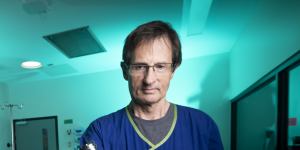
Professor David Kaye,director of cardiology at The Alfred,holds the newly arrived Bivacor total artificial heart.Wayne Taylor
The Australian government announced on Tuesday it would inject $50 million into the project to find an off-the-shelf alternative to organ donation,regarded as one of the holy grails of modern medicine.
The device weighs about 600 grams,but doesn’t look like any heart found in a human. It doesn’t beat;it whooshes. When inventor Daniel Timms takes one through airport security,he usually tells people it’s part of a car engine.
In the back office of his biotech firm,Bivacor,in the US,there are dozens of these pumps hooked up to test circulatory systems,pumping water day in day out,to show that they will keep whooshing,and pumping,in theory,for decades. Perhaps even a lifetime.
One heart Timms calls “the honey badger” has been running for five years,having first kept a cow alive for three months during a trial.
The secret is magnetic force,the same levitation technology behind Japan’s high-speed trains. It lets a rotor inside spin,pumping blood around the body,with the parts never touching,and never wearing out.
While the race to build a long-term artificial heart has been under way since the space race of the 1960s,lab-engineered hearts have always fallen short – all of them designed to replicate the squeezing pump of a real heart,usually via a flexible sac of compressed air,and all wearing out too quickly to be a viable alternative to a heart transplant. None have been approved for long-term use.
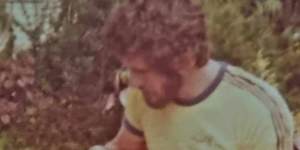
Daniel Timms in 1980 at two years old with his plumber dad,Gary,working on his elaborate garden of ponds,waterfalls and fountains.Courtesy of Daniel Timms
“Daniel’s heart is different,” said Monash University engineer Shaun Gregory. “It’s more like a fishtank pump than a heart ... It’s a revolution. It’s[the Wright brothers] inventing the plane to fly instead of trying to mimic birds’ wings flapping.”
Every year,millions die from heart failure – one person dies every three hours in Australia –but there are only thousands of heart transplants available worldwide. Even then,donor hearts only last about a decade,and the immunosuppressant drugs patients take to stop their body from rejecting them also make them sick,sometimes leading to cancer.
Some patients can be kept alive with a heart pump on one side of their hearts,or even two pumps if both sides are failing. “But the pumps don’t talk to each other,” said Professor David Kaye,who will help run the Australian Bivacor trial when it begins,likely late this year or early next at The Alfred hospital in Melbourne and St Vincent’s in Sydney.
“Sometimes you really just need to replace the whole heart.”
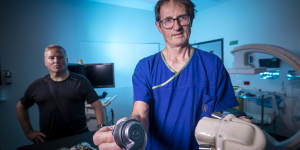
Professor David Kaye,director of cardiology at The Alfred with some of the first heart pumps used,and patient Peter Callinan,whose heart pump is top of the range right now.Wayne Taylor
At The Alfred where Kaye heads up cardiology,he lays out a showcase of old heart pumps. One monster,from the 1990s,is so wide and heavy it’s hard to imagine it ever fitting inside a human chest. “Today,pumps are still too big,” Kaye said. “And they’re still only temporary. Until transplant.”
Dubbed the,the new federal grant brings Bivacor and Monash together with a host of Australian universities and hospitals to develop technology for Timms’ artificial heart by 2025 as well as two new heart pump designs.
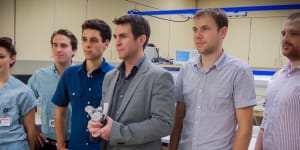
Daniel Timms (centre) is the founder and chief technical officer of Bivacor,which is developing a fully functional artificial heart.Bivacor
“Together,they’ll tackle all forms of heart failure,” said Gregory,and,it’s hoped,“create a new med-tech industry in Australia”.
Health Minister Mark Butler said the grant,awarded after an open competitive round,was the third-largest in the history of the Medical Research Future Fund.
“[This] Australian technology has the potential to halve deaths from heart failure,create thousands of jobs,and contribute $1.8 billion to Australia,” he said.
Kaye’s patient,Peter Callinan,has been waiting for a transplant since last June. A Heartmate 3,the top-of-the-line pump on the market right now,helps the left side of his heart beat in the meantime.
But Callinan’s life,like most patients,is a tangle of wires and battery bags,with the device’s main wire coming out of his abdomen,and stuck at one speed. “I’m like a Tesla,” quipped Callinan,who plugs directly into a socket overnight to charge his pump.
The father of three has to stay fit to remain eligible for a donor heart. But “once I hit a threshold,I can’t do any more,” he said.
Bivacor’s heart is smaller than other artificial hearts tried before – it can fit inside the chest of a child – and for the first time,it’s both long-lasting and responsive. The shape of its rotor blades mean the artificial heart speeds up and slows down automatically as someone’s activity level changes – just like a real heart.
“I 3D-printed every possible shape in the lab until the mechanics of that worked,” Timms said.
He first had the idea for his titanium heart as an engineering student in 2001,soon after his dad,Gary,had a heart attack. He’d grown up helping his plumber father build an elaborate garden of fountains and waterfalls in the backyard. So it was Gary he showed those early sketches of a rapidly spinning disc,pumping blood to both sides of the body,and soon father and son went to Bunnings to collect pipes and plastic for the first prototypes.
“I thought:‘The heart is just a pump’,” Timms said. “We build pumps for everything. Why not this?”
As Gary’s condition worsened,Timms took a replica to the cardiology team treating Gary in Brisbane. “[One doctor] slammed his fist down and said it’d never work because ‘you have to have a pulse’,” Timms recalled. But the other organised a small salary and a room downstairs in the hospital for Timms to work and wished him luck.
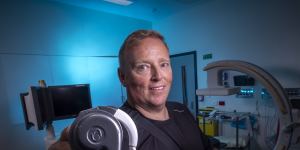
Patient Peter Callinan holding the latest heart pump on the market,one of which keeps him alive as he waits on the transplant list. But the new artificial heart could mean he never needs a transplant.Wayne Taylor
Soon more doctors came to see about all the strange banging going on in his office. He travelled the world meeting the top minds in artificial heart design,attending conferences,perfecting the design and eventually moving to the US to develop the technology at the renowned Texas Heart Institute,where they ran successful animal trials under the eminent surgeon Bud Frazier,who now consults on the Bivacor. Early on,Timms said he volunteered his engineering expertise on a host of projects to entice world experts,such as those who developed Japan’s high-speed rail,to help with his heart.
He even co-operated with NASA for two years to study their fail-safe systems,while engineers such as Gregory donated blood regularly to test how the device handled delicate blood vessels.
“Putting this heart in someone is like sending it into space,” Timms said. “You can’t just pop the hood if something goes wrong. We’re thinking like we’re building a space shuttle. We can’t make any mistakes. We test and test and test. My dad taught me that.”
In the final months of his father’s life,Timms worked harder than ever,rarely sleeping,half-convinced he could have the heart ready to save him.
Heart pump technology has always been born out of desperation,said Kaye,whose own invention will also be developed under the new grant.
Most failing hearts enlarge to try to cope,and find it harder to pump. But sometimes the heart muscle becomes too stiff,and can’t inflate as easily after each pulse. Right now,only drugs can treat that condition. But together Kaye and Gregory,who used to work in labs across from one another,have designed a new “mini-pump” small enough to fit inside the walls of a stiff heart to help.
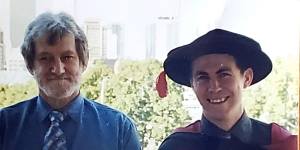
Gary and Daniel Timms after Daniel graduated with his PhD outlining the Bivacor design in 2005. Gary died six months later.Courtesy of Daniel Timms
“That’ll leverage some of the breakthroughs of Bivacor’s tech to get up and running next,” said Gregory,likely by 2029. A new design for a left-side pump like Callinan’s is also slated to hit the market by 2031.
Meanwhile,Timms’ heart already has US Food and Drug Administration approval for a trial in five American patients with both left- and right-side heart failure waiting for transplants,with Australian approval expected to follow soon,according to Kaye. Surgeons at St Vincent’s in Sydney have already briefly placed dummy replicas of the device inside the chests of heart transplant patients before they attached their donor organs,to check the design lined up correctly with the body’s plumbing. It did.
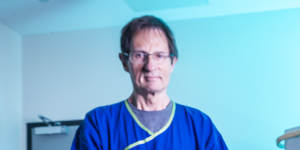
David Kaye with the new Bivacor artificial heart.Wayne Taylor
Next will be a large-scale international trial to take the device to market as a long-term permanent option,possibly as early as 2025,then work on next-generation wireless models so patients can charge their hearts without an external battery connection poking through the skin.
Callinan will be watching the little titanium heart closely.
“Every time a chopper goes overhead,me,the whole family are thinking,‘Could that be my heart?’” he said. “But it’s bittersweet. What if you could get a heart without someone having to die?”
Get the day’s breaking news,entertainment ideas and a long read to enjoy.